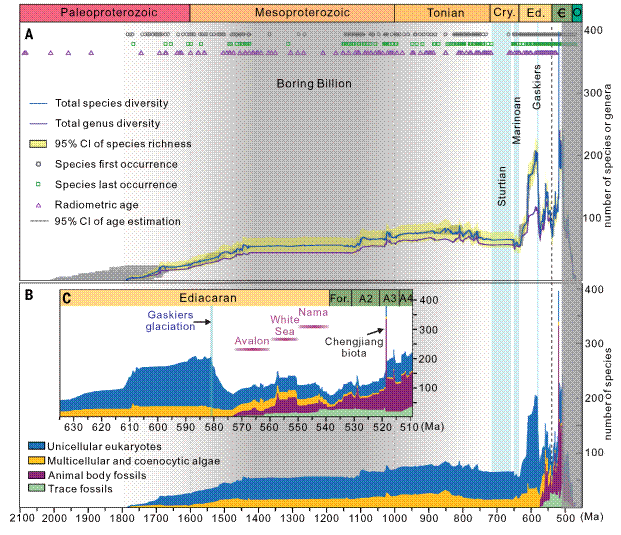Scientists’ big data analysis uncovers mysteries of early Earth evolution, helping search for extraterrestrial life

By establishing the biggest paleobiology database of early Earth to date and employing cutting-edge analytical tools, including supercomputer and artificial intelligence, an international paleontological research team led by Dr Qing Tang and Professor Shuzhong Shen from the School of Earth Sciences and Engineering at Nanjing University, for the first time, have constructed a high-resolution biodiversity curve spanning from 2 billion to 500 million years ago.
The findings were published in the academic Science journal on Friday. This study reveals that early life on Earth underwent a prolonged evolutionary journey, marked by multiple major radiations and mass extinctions before the formation of complex ecosystems around 500 million years ago.
"This study fills a critical gap in our understanding of the macroevolution of life on early Earth, providing a theoretical basis for elucidating the origins and early evolution of life, exploring the potential existence of extraterrestrial life, and assessing the sustainable development of a habitable Earth," Tang told the Global Times.
Fossils are the most direct evidence of life's evolution. However, when did life, particularly eukaryotes with a membrane-enveloped nucleus, originate and leave its first fossil record more than 500 million years ago? As the ancestors of all modern complex organisms, how did early life cope with environmental challenges and evolve into the diverse biosphere we see today?
These fundamental scientific questions, which are crucial for understanding our origins and future, have remained largely unaddressed for a long time due to methodological limitations, said Tang.
To tackle these questions, the research team spent six years developing a comprehensive paleobiology database of early Earth. By integrating big data analytical tools, such as supercomputing and artificial intelligence, Tang and his colleagues have established the first high-resolution biodiversity curve of early life.
The results indicate that the diversity of eukaryotes maintained low but stable growth since their earliest unambiguous fossil records around 1.7 billion years ago. However, this pattern was disrupted by the emergence of a global glaciation event around 720 million years ago.
Following the end of the glaciation event, life diversity began to increase rapidly and fluctuate frequently, leading to multiple episodes of major biological radiation and extinction.
These include a significant biological radiation event between approximately 635 and 580 million years ago, followed by the first mass extinction event in life history, which resulted in the sharp disappearance of the dominant organism - spiny microorganisms. Following this mass extinction, more complex macroscopic organisms, including animals, underwent rapid radiation. However, these complex macroscopic organisms encountered two significant declines in diversity at the end of the Ediacaran Period (approximately 551 to 539 million years ago), marking the earliest two mass extinction events in the evolutionary history of animals.
This study, by using big data analysis, quantitatively illustrate for the first time the first 1.5-billion-year evolutionary journey of fossilizable eukaryotes on Earth. It delineates the early history of complex life, including its origins, radiation, extinction, re-radiation, and the eventual formation of modern-like ecosystems.
"The findings suggest that extreme climate events, such as global glaciations, severely disrupted the evolutionary trajectory of Earth's early biosphere, leading to mass extinction events," Shen told the Global Times.
Following the end of glaciation events, the subsequent warming of surface temperatures and rise in atmospheric oxygen levels facilitated new radiations of increasingly complex organisms.
"This further confirms that the evolutionary pattern of life from simple to complex is not a straightforward linear process, but rather an alternating pattern of prolonged stagnation and relatively rapid radiation," Shen noted.
This study also highlights the profound impact of abrupt environmental changes, such as fluctuations in surface temperature and oxygen levels, on the evolution of early complex life systems, providing valuable insights for scientists searching for extraterrestrial life in extreme environments and assessing the future habitability of Earth.
"We study the relationship between biodiversity and the process of environmental evolution to better understand Earth's current state. This research helps predict how the planet might develop under environmental changes, offering valuable insights for the future," Shen remarked.
According to Shen, the development of life on Earth, from its origin to the growth of biodiversity, from simple to complex organisms, "provides valuable insights for studying whether other planets have similar conditions."
"Understanding the environmental factors that allowed early life on Earth to thrive and evolve into the biodiversity we see today can offer important clues for exploring the potential existence of life and biodiversity on other planets," he added.
Reviewers for Science journal commented: "This is, in many respects, a long overdue paper to examine the fossil record of the Proterozoic. This is a huge achievement. There will be a plethora of papers following publication of this paper doing just that."


